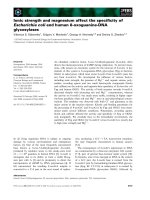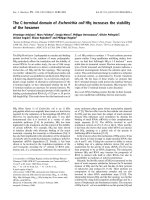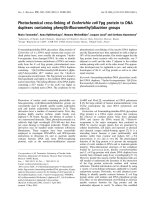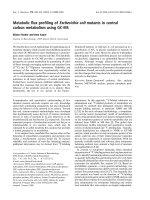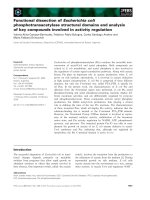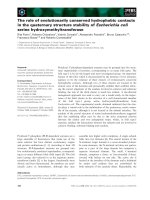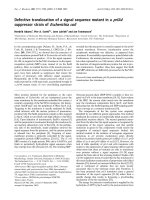Inactivation and repair of escherichia coli following UV disinfection influencing factors and photolyase activity
Bạn đang xem bản rút gọn của tài liệu. Xem và tải ngay bản đầy đủ của tài liệu tại đây (1.59 MB, 201 trang )
INACTIVATION AND REPAIR OF
ESCHERICHIA COLI FOLLOWING UV
DISINFECTION: INFLUENCING FACTORS
AND PHOTOLYASE ACTIVITY
QUEK PUAY HOON ELAINE
NATIONAL UNIVERSITY OF SINGAPORE
2008
INACTIVATION AND REPAIR OF
ESCHERICHIA COLI FOLLOWING UV
DISINFECTION: INFLUENCING FACTORS
AND PHOTOLYASE ACTIVITY
QUEK PUAY HOON ELAINE
(B. Eng., NUS)
A THESIS SUBMITTED FOR THE DEGREE OF
DOCTOR OF PHILOSOPHY
DEPARTMENT OF CIVIL ENGINEERING
NATIONAL UNIVERSITY OF SINGAPORE
2008
i
ACKNOWLEDGEMENTS
First and foremost, I would like to express my gratitude to my supervisor, Associate
Professor Hu Jiangyong. Her patient guidance and insightful comments throughout the
duration of the course have greatly contributed to the research conducted and the writing
of the thesis.
I wish also to extend my thanks to the laboratory manager, Mr Michael Tan, and the
laboratory officers, especially Mdm Tan Xiaolan and Mr Chandra. Their expertise in
microbiological techniques and laboratory procedures allowed the experiments to be
conducted smoothly, while their timely advice has helped me tackle problems during the
experiments.
In addition, many thanks go out to my fellow postgraduate students and research staff in
the laboratory, especially those in the “UV group”, who have made the hectic times in the
laboratory very enjoyable. The camaraderie among the postgraduate students has created
a highly conducive environment for working.
Last but not least, my utmost gratitude goes to my parents, sister and my fiancé, for their
constant encouragement, support and understanding throughout the last 4 years, without
which this thesis would not have been possible.
ii
TABLE OF CONTENTS
Page
ACKNOWLEDGEMENTS i
TABLE OF CONTENTS ii
SUMMARY vii
NOMENCLATURE x
LIST OF TABLES xii
LIST OF FIGURES xiii
CHAPTER 1 INTRODUCTION 1
1.1 Disinfection in Drinking Water Treatment 1
1.2 The Need for Alternative Disinfectants 1
1.3 Rise of UV Disinfection 2
1.4 DNA Repair – A Potential Drawback of UV Disinfection 3
1.5 Problem Statements 5
1.5.1 DNA repair following LP & MP UV disinfection 5
1.5.2 Factors affecting photoreactivation 6
1.5.3 Photoreactivation suppression by MP UV disinfection 8
1.6 Research Scope and Objectives 10
1.7 Organization of Thesis 13
CHAPTER 2 CURRENT STATE OF THE ART IN UV
DISINFECTION
16
2.1 Historical Development of UV Disinfection 16
2.2 Definition of UV Disinfection 18
Table of Contents
iii
2.3 UV Radiation Sources & UV Disinfection Systems 20
2.3.1 UV radiation sources 20
2.3.2 UV disinfection systems 24
2.4 UV Disinfection Mechanism 30
2.5 Factors affecting UV Disinfection 33
2.5.1 UV absorbance 33
2.5.2 Particle content 34
2.5.3 Intrinsic resistance of microorganisms 37
2.6 Advantages and Disadvantages of UV Disinfection 39
2.7 Applications of UV Disinfection 40
2.8 A Potential Problem in UV Disinfection: DNA Repair 43
2.9 Photoreactivation and the role of photolyases 44
2.9.1 Definition of photolyase and properties of photolyases 44
2.9.2 Photoreactivation mechanism 47
2.9.3 Photoreactivation of microorganisms after UV
disinfection
50
2.9.4 Factors affecting photoreactivation 53
2.9.5 Dark repair 58
2.10 UV Disinfection and DNA Repair of Escherichia coli 59
2.10.1 UV disinfection of E. coli 59
2.10.2 DNA repair of E. coli 61
CHAPTER 3 MATERIALS AND METHODS 66
3.1 Overview 66
3.2 Cellular-level Study 66
Table of Contents
iv
3.2.1 Bacteria strains 66
3.2.2 UV disinfection 68
3.2.3 Photoreactivation and dark repair 70
3.2.4 Bacteria enumeration 74
3.2.5 Data analysis using percentage log repair 74
3.3 Sub-cellular Level Study 76
3.3.1 Preparation of photolyase 77
3.3.2 UV irradiation of photolyase in vitro 79
3.3.3 Spectrophotometric assay for determination of
photolyase activity in vitro
80
3.3.4 Molecular detection of DNA repair 86
CHAPTER 4 INDICATORS FOR PHOTOREACTIVATION AND
DARK REPAIR STUDIES FOLLOWING UV
DISINFECTION
88
4.1 Background 88
4.2 UV Inactivation of E. coli 90
4.3 Photoreactivation of E. coli following UV Disinfection 94
4.4 Dark Repair of E. coli following UV Disinfection 100
4.5 Comparison of Repair of Selected Indicators and E. coli
O157:H7
104
4.6 Photoreactivation of Selected Indicator at High UV Doses 106
4.7 Photoreactivation of E. coli ATCC 15597 using ESS assay 109
4.8 Summary 114
Table of Contents
v
CHAPTER 5 PHOTOREACTIVATION OF ESCHERICHIA COLI
FOLLOWING UV DISINFECTION: EFFECTS OF
INCUBATION TEMPERATURE & LIGHT INTENSITY
115
5.1 Background 115
5.2 Effect of Fluorescent Light Intensity on Photoreactivation 117
5.3 Effect of Sunlight Intensity on Photoreactivation 120
5.4 Fluorescent Light vs Sunlight for Photoreactivation 126
5.5 Effect of Temperature on Photoreactivation 129
5.6 Photoreactivation of E. coli ATCC 11229 vs E. coli ATCC
15597
134
5.7 Summary 135
CHAPTER 6 IN VITRO EFFECTS OF UV RADIATION ON
ESCHERICHIA COLI DNA PHOTOLYASE:
IMPLICATIONS ON PHOTOREACTIVATION
FOLLOWING UV DISINFECTION
136
6.1 Background 136
6.2 Characteristics of Purified Photolyase 138
6.3 Effect of UV Radiation on Photolyase Activity 140
6.4 Effect of UV Radiation on Photolyase Activity in the Presence
of Dithiothreitol
145
6.5 Effect of Wavelengths in MP UV Radiation on Photolyase
Activity
148
6.5.1 Varying intensities of filtered radiation 151
6.5.2 Varying wavelengths at fixed intensity 154
6.6 Comparison of Photolyase Activity following Exposure to LP,
Filtered and Full-spectrum MP UV Radiation
157
6.7 Summary 158
Table of Contents
vi
CHAPTER 7 CONCLUSIONS & RECOMMENDATIONS FOR
FUTURE STUDY
160
7.1 Conclusions 160
7.2 Limitations and Recommendations for Future Study 164
REFERENCES 167
LIST OF PUBLICATIONS 183
vii
SUMMARY
DNA repair following UV disinfection is a potential problem in the use of UV
disinfection technology for drinking water treatment. In this thesis, photoreactivation and
dark repair of Escherichia coli following UV disinfection were examined at the cellular
and sub-cellular levels.
At the cellular level, the repair abilities of various E. coli strains with different
characteristics were studied and compared to that of pathogenic E. coli O157:H7. Up to
80% log repair was achieved with photoreactivation, while dark repair resulted in a
maximum of 25% log repair. Based on repair rates, E. coli ATCC 15597 and ATCC
11229 were selected as the photoreactivation and dark repair indicators, respectively,
following both low-pressure (LP) and medium-pressure (MP) UV disinfection. These
indicators were also assessed for their photoreactivation levels under varying conditions
of temperature and light intensity. E. coli ATCC 15597 was shown to achieve higher
photoreactivation levels than E. coli ATCC 11229 under all conditions tested.
Photoreactivation with fluorescent lights was also higher than that with high intensity
sunlight due to the germicidal effects of sunlight, suggesting that photoreactivation levels
in the natural environment could be overestimated when photoreactivation studies were
conducted with fluorescent lights. Temperature affected photoreactivation to a lesser
extent than light intensity, although it was observed that higher photoreactivation levels
were achieved at incubation temperatures close to the optimum growth temperatures of E.
coli. The results were similar for both LP and MP UV disinfection.
Abstract
viii
On the sub-cellular level, repair of DNA was analyzed using the endonuclease sensitive
site (ESS) assay. The results showed that the UV radiation-induced dimers were removed
continuously with time after UV irradiation. This confirms that the increase in E. coli
concentrations observed in the cellular level study was a result of the repair of dimers in
DNA. Light repair was also confirmed to be more efficient than dark repair in the
removal of dimers.
Other than the molecular level study, the photoreactivating enzyme, photolyase, was
extracted and purified from E. coli, and assessed for its dimer repair ability in vitro
following exposure to LP and MP UV disinfection. The dimer repair rates of photolyase
were unaffected by LP UV disinfection up to a UV dose of 10 mJ/cm
2
, after which the
rates started to decrease with increasing UV doses up to 40 mJ/cm
2
. On the other hand,
photolyase exposed to MP UV radiation showed an immediate decrease in dimer repair
rates which leveled off so that the dimer repair rates were similar to that of LP-irradiated
photolyase at 40 mJ/cm
2
. The results suggest that there is an adverse effect of UV
radiation on dimer repair by photolyase, which most likely led to the decreased
photoreactivation levels at high UV doses and with MP UV radiation. Several
wavelengths (254, 266, 280 and 365 nm) were also filtered from MP UV radiation and
used to irradiate photolyase at intensities ranging from 0.03 to 0.20 mW/cm
2
. Dimer
repair rates of photolyase exposed to wavelengths less than 300 nm decreased with UV
dose. Radiation at 365 nm appeared to enhance dimer repair rates at low intensities, and
then reduced dimer repair rates at higher intensities. The results here imply that
photoreactivation suppression by MP UV radiation was not attributed to a single
Abstract
ix
wavelength, but is most likely due to the combined exposure to a broad spectrum of
radiation.
Keywords: DNA repair, dark repair, Escherichia coli, photolyase, photoreactivation, UV
disinfection
x
NOMENCLATURE
ATCC American Type Culture Collection
BER Base excision repair
CCUG Culture Collection, University of Göteborg
CFU/ml Colony forming units per milliliter
C. parvum Cryptosporidium parvum
CPDs Cyclobutane pyridimine dimers
DBPs Disinfection by-products
DNA Deoxyribonucleic acid
DTT Dithiothreitol
E. coli Escherichia coli
ESS Endonuclease sensitive site
FAD Flavin adenine dinucleotide
IPTG Isopropylthio-β-D-galactoside
LP Low-pressure
ml Milliliter(s)
MP Medium-pressure
MTHF Methenyltetrahydrofolate
NaCl Sodium chloride
NCIMB National Collection of Industrial, Marine and Food Bacteria
NER Nucleotide excision repair
nm Nanometers
Nomenclature
xi
PRE Photoreactivating enzyme (photolyase)
RNA Ribonucleic acid
rpm revolutions per minute
THMs Trihalomethanes
TSB Tryptic soy broth
USEPA United States Environmental Protection Agency
UV Ultraviolet
v/v Volume fraction
xii
LIST OF TABLES
Page
Table 2-1 Ultraviolet light wavelength regions 19
Table 2-2 Range of UV doses required for inactivation of various
microorganisms
38
Table 2-3 Applications of UV disinfection 41
Table 2-4 Physical properties of photolyases isolated from different
organisms
46
Table 3-1 Characteristics of E. coli strains used 67
Table 4-1 UV doses (mJ/cm
2
) required for 5-log inactivation of various
Escherichia coli strains
93
Table 4-2 Photoreactivation data for Escherichia coli strains ATCC 15597
and ATCC 700891 following LP and MP UV disinfection
99
Table 4-3 Dark repair data for Escherichia coli strains ATCC 15597 and
ATCC 700891 following LP and MP UV disinfection
103
Table 5-1 Percentage log recovery of E. coli ATCC 11229 and ATCC 15597
following 4 h of fluorescent light and sunlight exposure with LP
and MP UV disinfection
126
Table 5-2 Comparison of repair rates of E. coli ATCC 11229 and ATCC
15597 following LP UV disinfection and incubation under varying
light and temperature conditions
130
Table 6-1 Rate of dimer repair of LP- and MP-UV irradiated photolyase with
and without DTT addition
147
List of Figures
xiii
LIST OF FIGURES
Page
Figure 1-1 Schematic diagram showing various phases of research study 12
Figure 2-1 Electromagnetic spectrum 18
Figure 2-2 Emission spectrum of a typical (A) low-pressure (LP) UV lamp
and (B) medium-pressure (MP) UV lamp
22
Figure 2-3 Emission spectrum of a xenon flashlamp 24
Figure 2-4 Schematic diagram of a typical bench-scale setup with the
collimated beam UV system
25
Figure 2-5 Schematic diagram of a flow-through UV disinfection system 27
Figure 2-6 Formation of a thymine-thymine dimer by UV radiation 31
Figure 2-7 Comparison of action spectrum of E. coli inactivation to the
absorption spectrum of nucleic acids
32
Figure 2-8 Structure of the chromophores of DNA photolyases 45
Figure 2-9 Process of photoreactivation 47
Figure 2-10 Structure of E. coli DNA photolyase in a ribbon presentation 49
Figure 2-11 Ultraviolet dose required for 99% inactivation of selected
bacterial and viral microorganisms
52
Figure 3-1 Collimated beam apparatus for UV disinfection 68
Figure 3-2 Emission spectra of (A) LP and (B) MP UV lamps used in the
study
69
Figure 3-3 Spectrum of fluorescent light used in photoreactivation
experiments
71
Figure 3-4 Setup for photoreactivation experiments 72
Figure 3-5 Spectrum of sunlight employed for photoreactivation in the
study for sunlight intensity of 60 kLux
73
List of Figures
xiv
Figure 3-6 Experimental setup for photoreactivation experiments with
sunlight – (A) Water bath and (B) Temperature control system
for water bath
73
Figure 3-7 Decrease in absorbance of oligo-dT
18
at 260 nm with time of
irradiation using a 257-nm lamp
81
Figure 3-8 Change in absorption spectrum of un-irradiated photolyase-
substrate mixture as thymine dimers are repaired
82
Figure 3-9 Increase in A
260
of photolyase-substrate mixture with time of
exposure to photoreactivating light at 365 nm
84
Figure 4-1 UV inactivation of various E. coli strains by (A) LP and (B) MP
UV disinfection
91
Figure 4-2 Percentage log repair of various E. coli strains after exposure to
fluorescent light following (A) LP and (B) MP UV disinfection
95
Figure 4-3 Photoreactivation of log phase (4 h) and stationary phase (21 h)
cultures of E. coli NCIMB 10083 after exposure to fluorescent
light following MP UV disinfection
97
Figure 4-4 Photoreactivation rates of various E. coli strains following LP
and MP UV disinfection
99
Figure 4-5 Percentage log repair of various E. coli strains after incubation
in the dark following (A) LP and (B) MP UV disinfection
101
Figure 4-6 Comparison of the final log concentrations of E. coli O157:H7
and selected indicator strains following exposure to (A)
fluorescent light and (B) dark conditions after LP and MP UV
disinfection at doses of 2, 5 and 8 mJ/cm
2
105
Figure 4-7 Increase in E. coli ATCC 15597 concentrations with time of
exposure to fluorescent light following LP (solid line) and MP
(dashed line) UV disinfection with doses of 20 (□) and 40 (○)
mJ/cm
2
.
107
Figure 4-8 Changes in median molecular length of E. coli ATCC 15597
DNA with exposure to LP UV doses of (A) 1 mJ/cm
2
, (B) 2
mJ/cm
2
and MP UV doses of (C) 1 mJ/cm
2
and (D) 5 mJ/cm
2
,
followed by incubation under fluorescent light or in the dark for
up to 4 h
109
List of Figures
xv
Figure 4-9 Final median molecular lengths of E. coli ATCC 15597 DNA
with exposure to LP and MP UV doses of 1 mJ/cm
2
and 5
mJ/cm
2
, followed by incubation under fluorescent light or in the
dark for 4 h
112
Figure 4-10 Comparing trends from cellular level study (% log repair) and
molecular level study (median molecular lengths)
113
Figure 5-1 Percentage log recovery of E. coli strains ATCC 11229 (Panels
A & B) and ATCC 15597 (Panels C & D) with time of
incubation under varying photoreactivating fluorescent light
intensities following LP (filled symbols) and MP (open symbols)
UV irradiation.
118
Figure 5-2 Percentage log recovery of (A) E. coli ATCC 11229 and (B) E.
coli ATCC 15597 with time of incubation under sunlight of
varying intensities following LP and MP UV irradiation
121
Figure 5-3 Concentrations (log CFU/ml) of un-irradiated E. coli
suspensions with exposure to (a) low intensity and (b) high
intensity sunlight
124
Figure 5-4 Rate of light repair (log recovery per hour) under conditions of
varying fluorescent light and sunlight intensities following LP
and MP UV disinfection by E. coli ATCC 11229
128
Figure 5-5 Percentage log recovery values of E. coli ATCC 11229 and E.
coli ATCC 15597 after LP and MP UV disinfection, followed by
4 h of incubation at various temperatures and constant light
intensity of 11.5 kLux
131
Figure 5-6 Concentrations (log CFU/ml) of un-irradiated E. coli ATCC
15597 and ATCC 11229 suspensions incubated at 50°C
132
Figure 6-1 SDS-PAGE image showing presence of photolyase in various
steps of purification
138
Figure 6-2 UV-VIS absorption spectrum of purified photolyase (diluted ten-
fold with assay buffer)
139
Figure 6-3 Repair rates of photolyase exposed to varying doses of LP and
MP UV radiation
141
Figure 6-4 Repair rates of photolyase exposed to varying doses of LP and
MP UV radiation, and chemically reduced by the addition of 5
mM DTT
146
List of Figures
xvi
Figure 6-5 The various redox states of the 7,8-dimethyl isoalloxazine
moiety of FAD
148
Figure 6-6 UV-VIS absorption spectrum of purified photolyase (dashed
line) and emission spectrum of MP UV lamp (solid line)
150
Figure 6-7 Emission spectra of MP UV radiation filtered with (A) 266 nm
(solid line) and 365 nm (dashed line) and (B) 254 nm (solid line)
and 280 nm (dashed line) optical bandpass filters
151
Figure 6-8 Dimer repair rates of photolyase exposed to various doses and
intensities of MP UV radiation filtered with (A) 254 nm, (B) 266
nm, (C) 280 nm and (D) 365 nm optical bandpass filters
152
Figure 6-9 Dimer repair rates of photolyase exposed to various doses of MP
radiation filtered with different bandpass filters at a fixed
intensity of 0.05 mW/cm
2
.
155
Figure 6-10 Dimer repair rates of photolyase exposed to LP UV radiation,
MP UV radiation filtered with a 254 nm optical bandpass filter,
and full spectrum MP UV radiation, expressed as a percentage of
photolyase not exposed to UV radiation
157
Chapter 1 Introduction
1
CHAPTER 1 INTRODUCTION
1.1 Disinfection in Drinking Water Treatment
Water is one of the most important commodities that are necessary for human survival.
Unfortunately, it is also one of the most common modes of transmission of disease-
causing agents. In the past, the consumption of non-treated or non-disinfected water were
the main causes of major outbreaks of diseases such as typhoid and cholera, resulting in
thousands of deaths worldwide in the 1800s and 1900s. In the late 1800s, it was
discovered that the occurrence of these diseases were linked to the consumption of ‘dirty
water’, which contained disease-causing agents. This finding led to the use of
disinfectants in order to combat epidemics, which was successfully accomplished in
Chicago in 1908 to contain a typhoid outbreak. Since then, water disinfection has become
an integral part of potable water treatment. The main objective of disinfection is to reduce
pathogen concentrations to levels that will not cause adverse effects on human beings
upon ingestion of, or exposure to, the water. It is usually implemented at the ending
stages of the treatment train to serve as a final barrier between human beings and
waterborne diseases. Therefore, having an appropriate disinfection technology can
prevent the occurrence and spread of water-related diseases, thereby minimizing public
health problems.
1.2 The Need for Alternative Disinfectants
Ever since disinfection was first introduced in water treatment, chlorine has remained the
most commonly used disinfectant. This is mainly because chlorine is a by-product of
Chapter 1 Introduction
2
many industrial processes and is thus readily available at low cost. It has also been easily
implemented on a large-scale in water treatment plants. However, the use of chlorine for
disinfection has come under close scrutiny in recent decades due to the publication of a
report in the mid-1970s which showed that the reaction of chlorine with organic
compounds in water can produce by-products such as trihalomethanes (THMs) which
may be carcinogenic. The possible long-term adverse health effects of these by-products
have prompted the enforcement of stricter regulations with regards to disinfection by-
product (DBP) levels in drinking water, and have subsequently affected the use of
chlorine as a disinfectant. In addition, there has also been an emergence of chlorine-
resistant viruses and protozoa, most notably Cryptosporidium parvum which has caused a
few major waterborne outbreaks in North America recently. Other disadvantages such as
the hazards involved in the transporting and storing of toxic chlorine have contributed to
the fall of chlorination as the favored disinfection technology. In view of the inability of
chlorine to disinfect certain emerging pathogens and the harmful health effects of
chlorinated DBPs, many treatment plants have started to switch from chlorination to
other disinfectants such as chloramination, ozonation and ultraviolet disinfection.
1.3 Rise of UV Disinfection
Of the various disinfectants considered, one technology that has emerged as a highly
popular alternative to chlorination is ultraviolet (UV) disinfection. Unlike chemical
disinfectants, UV disinfection employs a unique mechanism of DNA damage to prevent
the pathogens from reproducing and to achieve reduction in pathogen concentrations.
Such a mechanism is swift and accurate, utilizing only a short time to inactivate most
Chapter 1 Introduction
3
pathogens to very low levels. However, one of the main attractiveness of this technology
lies in its ability to inactivate chlorine-resistant bacteria, some viruses and protozoa (e.g.
Giardia lamblia and Cryptosporidium parvum) at very low doses without the formation
of harmful DBPs. As such, the strict DBP regulations which have been implemented can
be easily met. In addition to its excellent disinfection capabilities, it also appeals to water
authorities due to its small footprint. This is because low UV doses are required for
effective inactivation, so that the retention times are short, and therefore translates into
smaller-sized reactors as compared to those for chlorination. Another advantage that UV
disinfection has over chlorination is that it is a physical process, so that the costs and
risks involved in the handling, transportation and storage of toxic chemicals need not be
incurred. Being a physical process, the performance efficiency is also not affected by the
pH and temperature of the water, so that the disinfection process can be easily controlled.
There is therefore greater operational reliability in using UV disinfection than with
chemical disinfectants. These benefits of UV disinfection are currently pushing the
technology into prominence. The most common application of UV disinfection in water
and wastewater treatment is the final disinfection step before consumption or disposal,
respectively. There is also increasing interest in the use of UV disinfection coupled with
UV oxidation, by the application of higher UV doses, and thus this technology is likely to
be used for disinfection and decontamination in the future.
1.4 DNA repair – A Potential Drawback of UV Disinfection
Despite the advantages afforded by UV disinfection, the technology has a few
shortcomings. The disinfection process can be hindered by the presence of turbidity or
Chapter 1 Introduction
4
UV-absorbing chemicals such as humic acids, iron and manganese ions because they can
protect the microorganisms from UV radiation. Furthermore, another major drawback is
DNA repair, which is prevalent among microorganisms and can reverse the disinfection
effects of UV radiation. Bacteria are known to possess the ability to repair the DNA
damage caused by UV disinfection via various repair mechanisms, resulting in the
reactivation of the bacteria after the water leaves the treatment plant and re-contamination
of the treated water. As a result of the DNA repair processes, the overall efficiency of UV
disinfection is reduced and this is particularly significant when visible light exposure
following UV disinfection is involved. Reactivation of bacteria following UV
disinfection is of great consequence, so that this topic has been voraciously investigated
in the last decade or so, and much information has been published in this area. However,
with the advent of newer and improved UV lamps such as the high intensity medium-
pressure (MP) UV lamps, the problem of reactivation needs to be reassessed and
continually examined to determine the extent of the problem and to understand it so that
preventive methods can be adopted. It has also been reported that water treatment plants
utilizing UV disinfection are increasing in recent decades (Hassen et al., 2000) and will
continue to emerge as one of the most popular alternatives to chlorination. Hence,
research in the area of microbial reactivation following UV disinfection is ever more
critical.
Chapter 1 Introduction
5
1.5 Problem Statements
1.5.1 DNA repair following LP and MP UV disinfection
DNA repair includes both photoreactivation and dark repair, and researchers have been
investigating these processes since the early 1900s. However, research into DNA repair
following UV disinfection has only been conducted since UV disinfection came into
prominence in the 1990s. Even so, most studies have been performed with the traditional
low-pressure (LP) UV disinfection.
Studies have shown that both photoreactivation and dark repair take place following LP
UV disinfection, with dark repair occurring to a much lesser extent than
photoreactivation. This is a cause for concern, since the microorganisms that have
repaired the damaged DNA can then reproduce and potentially cause diseases when the
water is consumed.
With the advent of MP UV lamps in the late 1990s, DNA repair after disinfection with
MP UV lamps is now an important area of research. Currently, there is limited
information on photoreactivation and repair following MP UV disinfection, especially for
pathogens. So far, two studies have been conducted with E. coli irradiated with MP UV
lamps and found that both photoreactivation and dark repair were negligible as compared
with LP UV lamps (Oguma et al., 2002; Zimmer and Slawson, 2002). However, another
study reported high levels of photoreactivation with MP UV disinfection of E. coli,
although the extent of photoreactivation was lower than that of LP UV disinfection (Hu et
al., 2005). One reason for the contradictory results was the use of different strains of E.
Chapter 1 Introduction
6
coli in the studies. Although the use of the indicator bacteria, E. coli, was consistent in all
three studies, it is apparent that the repair abilities of various strains of the same bacteria
can differ to a great extent. Since DNA repair is an important area of research and is
conducted under varying conditions (light intensity, E. coli strains, temperature, light
source, applied UV doses, etc) with different research groups, there is a need to identify a
strain that can be used as an indicator for DNA repair studies to represent pathogens, so
that comparisons across different studies with different repair conditions can be made
more meaningful.
Currently, there is also limited information on repair of pathogenic bacteria. Two studies
have been conducted on pathogenic E. coli (Tosa and Hirata, 1999; Sommer et al., 2000).
Tosa and Hirata (1999) reported that light repair was observed for pathogenic E. coli
O26, but not for E. coli O157:H7. Sommer et al (2000), on the other hand, observed
apparent light repair for all tested pathogenic E. coli strains, including E. coli O157:H7.
Dark repair was found to play a limited role in DNA repair, except for E. coli O50:H7.
However, these results were only valid for LP UV disinfection. There is inadequate
information on the repair of E. coli O157:H7 after MP UV disinfection and this area
needs to be properly investigated since pathogens are the main targets for disinfection.
1.5.2 Factors affecting photoreactivation
Photoreactivation is a DNA repair process that requires visible light energy, and is
responsible for the repair of up to 80% of the DNA damage caused by UV radiation.
Hence, it is of great significance in UV disinfection. Many studies have been conducted
Chapter 1 Introduction
7
on photoreactivation, with emphasis on the varying conditions under which
photoreactivation can take place and the relevant influencing factors.
Given that the presence of visible light is a pre-requisite for photoreactivation to occur,
one of the foremost influencing factors of photoreactivation is light intensity.
Photoreactivation has been found to increase with increasing light intensity. These studies
mostly used fluorescent light in indoor environments where the light intensity parameters
and other conditions can be easily controlled. However, in the natural environment, the
water that is treated is exposed to sunlight, which has greatly differing properties from
that of fluorescent light. Moreover, studies on the effects of light intensity on
photoreactivation have so far only employed very low photoreactivating light intensities,
while exposure of the water to much higher intensities is very likely in the natural
environment. Therefore, information on the effects of high intensity fluorescent light and
sunlight on photoreactivation after UV disinfection is limited and this area of research
therefore needs more evaluation and investigation.
Other than light intensity, temperature can also play an important role in
photoreactivation because the photoreactivation is essentially a biological process. So far,
photoreactivation studies have controlled the incubation temperature at room temperature
(i.e., 23°C – 25°C), which may not be the case in the natural environment, where summer
temperatures can be as high as 35°C and winter temperatures can be as low as 0°C. Since
UV disinfection is being implemented at water treatment plants worldwide,
photoreactivation of bacteria under varying temperatures should be assessed.

